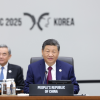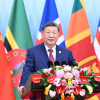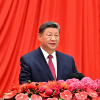热词翻译:“革命老区、民族地区、边疆地区、贫困地区”英文怎么说?
“革命老区、民族地区、边疆地区、贫困地区”英文怎么说?
根据热词译文件报告翻译数据库,在《中共中央关于党的百年奋斗重大成就和历史经验的决议》的翻译中,“革命老区、民族地区、边疆地区、贫困地区”被翻译为:
革命老区、民族地区、边疆地区、贫困地区
old revolutionary base areas, areas with large ethnic minority populations, border areas, and impoverished areas
old revolutionary base areas, areas with large ethnic minority populations, border areas, and impoverished areas
例句如下:
党实施区域协调发展战略,促进京津冀协同发展、长江经济带发展、粤港澳大湾区建设、长三角一体化发展、黄河流域生态保护和高质量发展,高标准高质量建设雄安新区,推动西部大开发形成新格局,推动东北振兴取得新突破,推动中部地区高质量发展,鼓励东部地区加快推进现代化,支持革命老区、民族地区、边疆地区、贫困地区改善生产生活条件。推进以人为核心的新型城镇化,加强城市规划、建设、管理。
The Party has introduced a coordinated regional development strategy. It has promoted coordinated development of the Beijing-Tianjin-Hebei region, the development of the Yangtze Economic Belt and the Guangdong-Hong Kong-Macao Greater Bay Area, integrated development in the Yangtze River Delta, ecological protection and high-quality development in the Yellow River basin, and high-quality construction of Xiongan New Area to a high standard. The Party has prompted a new phase in the large-scale development of the western region, new breakthroughs in the revitalization of the northeast, and high-quality development of the central region, and encouraged the eastern region to accelerate its pace of modernization. The Party has provided assistance for improving working and living conditions in old revolutionary base areas, areas with large ethnic minority populations, border areas, and impoverished areas. It has promoted a new, people-centered type of urbanization and improved urban planning, development, and management.
The Party has introduced a coordinated regional development strategy. It has promoted coordinated development of the Beijing-Tianjin-Hebei region, the development of the Yangtze Economic Belt and the Guangdong-Hong Kong-Macao Greater Bay Area, integrated development in the Yangtze River Delta, ecological protection and high-quality development in the Yellow River basin, and high-quality construction of Xiongan New Area to a high standard. The Party has prompted a new phase in the large-scale development of the western region, new breakthroughs in the revitalization of the northeast, and high-quality development of the central region, and encouraged the eastern region to accelerate its pace of modernization. The Party has provided assistance for improving working and living conditions in old revolutionary base areas, areas with large ethnic minority populations, border areas, and impoverished areas. It has promoted a new, people-centered type of urbanization and improved urban planning, development, and management.
热词链接
“革命老区、民族地区、边疆地区、贫困地区”在其他来源中的翻译:
1 《《人类减贫的中国实践》白皮书》中“革命老区、民族地区、边疆地区、贫困地区”的翻译
优秀文化传承弘扬。加强贫困地区传统文化、特色文化、民族文化的保护、传承和弘扬,贫困地区优秀文化繁荣发展。实施国家传统工艺振兴工程,引导和推动革命老区、民族地区、边疆地区、贫困地区保护好、发展好当地优秀传统技艺。支持贫困地区深入挖掘民族文化、红色文化、乡土文化、非物质文化遗产特色资源,加强保护研究、人才培养、展示推广,打造特色文化旅游产业。开展留存扶贫印记活动,建立贫困村扶贫档案,鼓励支持扶贫题材影视文艺作品创作,生动记录脱贫致富历程。贫困地区优秀文化的保护传承,既促进了贫困群众增收致富,也延续了文脉、留住了乡愁。
Cultural heritage has been protected. China has strengthened the protection and promotion of traditional culture, folk culture and ethnic culture in poor areas to maintain a wealth of cultural diversity. It has implemented the Plan on the Revitalization of Traditional Chinese Craftsmanship to protect and develop fine craftsmanship in old revolutionary base areas, areas with large ethnic minority populations, border areas, and poverty-stricken areas. It has supported poor areas to develop cultural resources with local characteristics, including ethnic culture, revolutionary sites, folk culture, and intangible cultural heritage. Local governments in poor areas have developed tourism there by conserving and promoting these cultural resources and training support staff. China has paid attention to keeping a record of the experiences of ordinary people in poverty alleviation, such as archives of poor villages, films, TV programs and literary works themed on poverty alleviation. Through the protection and promotion of cultural heritage in poor areas, the impoverished have gained additional income while retaining their cultural roots.
Cultural heritage has been protected. China has strengthened the protection and promotion of traditional culture, folk culture and ethnic culture in poor areas to maintain a wealth of cultural diversity. It has implemented the Plan on the Revitalization of Traditional Chinese Craftsmanship to protect and develop fine craftsmanship in old revolutionary base areas, areas with large ethnic minority populations, border areas, and poverty-stricken areas. It has supported poor areas to develop cultural resources with local characteristics, including ethnic culture, revolutionary sites, folk culture, and intangible cultural heritage. Local governments in poor areas have developed tourism there by conserving and promoting these cultural resources and training support staff. China has paid attention to keeping a record of the experiences of ordinary people in poverty alleviation, such as archives of poor villages, films, TV programs and literary works themed on poverty alleviation. Through the protection and promotion of cultural heritage in poor areas, the impoverished have gained additional income while retaining their cultural roots.
2 《2020年政府工作报告》中“革命老区、民族地区、边疆地区、贫困地区”的翻译
促进革命老区、民族地区、边疆地区、贫困地区加快发展。发展海洋经济。
We will encourage accelerated development in old revolutionary base areas, ethnic minority areas, border areas, and poor areas. We will develop the maritime economy.
We will encourage accelerated development in old revolutionary base areas, ethnic minority areas, border areas, and poor areas. We will develop the maritime economy.
3 《2019年政府工作报告》中“革命老区、民族地区、边疆地区、贫困地区”的翻译
六是统筹城乡区域发展,良性互动格局加快形成。乡村振兴战略有力实施,粮食总产量保持在1.3万亿斤以上。新型城镇化扎实推进,近1400万农业转移人口在城镇落户。推进西部开发、东北振兴、中部崛起、东部率先发展,出台一批改革创新举措。京津冀协同发展取得明显进展,长江经济带生态优先、绿色发展格局不断巩固。粤港澳大湾区规划建设迈出实质性步伐,港珠澳大桥建成通车。加大对革命老区、民族地区、边疆地区、贫困地区改革发展支持力度。
Sixth, we pursued balanced development across rural and urban areas and regions and sped up the formation of a pattern of positive interplay. The rural revitalization strategy was implemented with vigor; grain output was kept above 650 million metric tons. Solid progress was made in the pursuit of new urbanization, and close to 14 million people originally from rural areas gained permanent urban residency. A full range of reforms and innovative measures were introduced to advance development in the western region, revitalize the northeast, energize the central region, and support the eastern region in spearheading development. Major progress was made in boosting the coordinated development of the Beijing-Tianjin-Hebei region. Along the Yangtze Economic Belt, efforts to prioritize ecological conservation and boost green development were strengthened. Substantive steps were taken in the planning and building of the Guangdong-Hong Kong-Macao Greater Bay Area, and the Hong Kong-Zhuhai-Macao Bridge was opened to traffic. We expanded support for reforms and development in old revolutionary base areas, areas with large ethnic minority populations, border areas, and poor areas.
Sixth, we pursued balanced development across rural and urban areas and regions and sped up the formation of a pattern of positive interplay. The rural revitalization strategy was implemented with vigor; grain output was kept above 650 million metric tons. Solid progress was made in the pursuit of new urbanization, and close to 14 million people originally from rural areas gained permanent urban residency. A full range of reforms and innovative measures were introduced to advance development in the western region, revitalize the northeast, energize the central region, and support the eastern region in spearheading development. Major progress was made in boosting the coordinated development of the Beijing-Tianjin-Hebei region. Along the Yangtze Economic Belt, efforts to prioritize ecological conservation and boost green development were strengthened. Substantive steps were taken in the planning and building of the Guangdong-Hong Kong-Macao Greater Bay Area, and the Hong Kong-Zhuhai-Macao Bridge was opened to traffic. We expanded support for reforms and development in old revolutionary base areas, areas with large ethnic minority populations, border areas, and poor areas.

 习近平在亚太经合组织第三十二次领导人非正式会议第一阶段会议上的讲话
习近平在亚太经合组织第三十二次领导人非正式会议第一阶段会议上的讲话 习近平在全球妇女峰会开幕式的主旨讲话
习近平在全球妇女峰会开幕式的主旨讲话 习近平在庆祝中华人民共和国成立76周年招待会上的讲话
习近平在庆祝中华人民共和国成立76周年招待会上的讲话 习近平在金砖国家领导人线上峰会的讲话
习近平在金砖国家领导人线上峰会的讲话 习近平:在纪念中国人民抗日战争暨世界反法西斯战争胜利80周年招待会上的讲话
习近平:在纪念中国人民抗日战争暨世界反法西斯战争胜利80周年招待会上的讲话